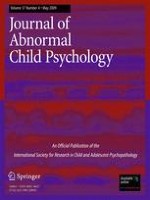01-05-2009
Mediational Pathways Through Which Positive and Negative Emotionality Contribute to Anhedonic Symptoms of Depression: A Prospective Study of Adolescents
Gepubliceerd in: Research on Child and Adolescent Psychopathology | Uitgave 4/2009
Log in om toegang te krijgenAbstract
This study takes a developmental psychopathological approach to examine mechanisms through which baseline levels of positive emotionality (PE) and negative emotionality (NE) prospectively predict increases in anhedonic depressive symptoms in a community sample of 350 adolescents (6th–10th graders). Dependent stressors mediated the relationship between baseline levels of NE and anhedonic depressive symptoms after controlling for initial symptoms. Supportive relationships mediated the relationship between baseline levels of PE and anhedonic depressive symptoms, after controlling for baseline symptoms. In addition, NE X PE interacted to predict later anhedonic depressive symptoms, such that adolescents with low levels of PE and high levels of NE experienced the greatest increase in anhedonic depressive symptoms. Last, supportive relationships interacted with baseline PE to predict prospective changes in anhedonic depressive symptoms, such that adolescents with low PE and low supportive relationships experienced the greatest increase in anhedonic depressive symptoms. Results are discussed in terms of current theoretical models of the link between temperament and depression.
